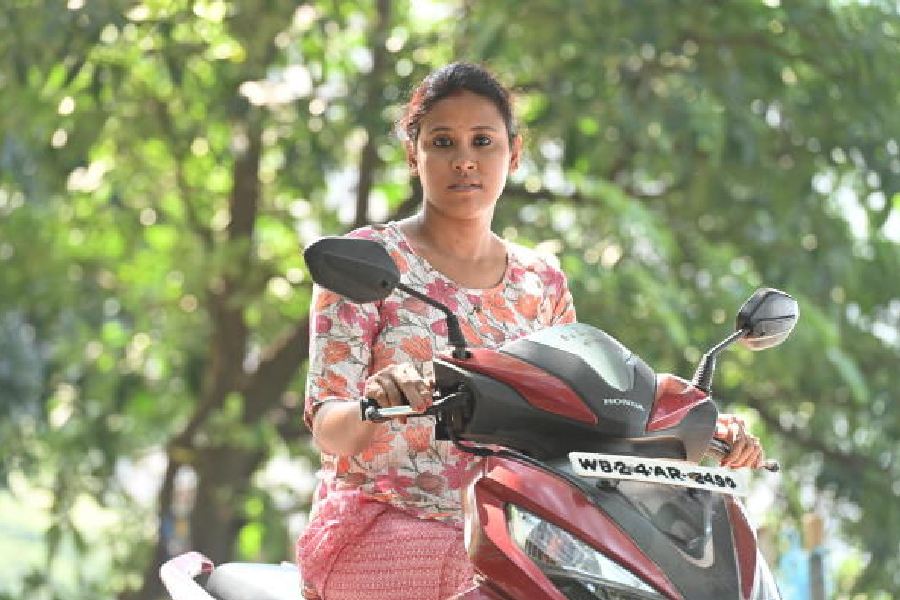Her first client was a 58-year-old woman. In 2022, when the Covid pandemic had begun to recede, Puja Srivastava was approached by the woman, who wanted to be taught how to ride a scooty.
The senior woman just wanted to be not too dependent on others, to feel free. Puja, 30, had the right credentials to train her.
A resident of Bonhooghly in north Calcutta, Puja had grown up with vehicles. Her father teaches driving four-wheelers. From an early age, she was familiar with both four-wheelers and two-wheelers and had turned into an excellent driver herself of both kinds of vehicles.
Her father would often ask her to teach women to drive cars or two-wheelers, as he would get queries about women trainers. Many women would prefer a woman trainer to a man. But Puja had a small child — her son is seven now — and other cares.
Two years ago, however, when she was approached by the 58-year-old, she just said yes.
“She was fearless. She said, ‘I don’t care if I fall. Just teach me’,” laughs Puja, a cheerful, confident, attractive person, who inspires confidence in others. Age is no bar, she reminds, to learn to ride a scooty, as with several other things.
Till date, Puja has given 63 women scooty lessons, for a fee, and set them on the road to freedom. At least a little bit.
The freedom lies not only in being able to negotiate traffic while riding one’s own vehicle.
“Most women who come to me are married, with children,” says Puja. Riding a scooty helps them to drop their children at school and pick them up without being dependent on their husbands. This makes a great difference to households. “So many women approach me, but many of them are also afraid,” laughs Puja.
“When someone feels very tense, and it is natural, because some of the women do not even know how to cycle, and they see huge trucks and buses coming towards them, I increase the speed,” laughs Puja. It is throwing someone into the deep end, in a way, though potholes are another big challenge. As are bumps. “But soon she begins to enjoy the ride.”
She loses her fear. Which is the key to learning. And to being confident, an essential requirement in a vehicle driver, something women are often socially conditioned not to possess.
As we all see, fear holds a woman back, on the road, elsewhere, because the public space is often designed to exclude her, if not damage her.
Puja starts her lessons early morning, from one of two spots near her home. After her marriage, she became a resident of Rathtala, not too far from Bonhooghly. “My husband is absolutely supportive,” she says proudly. She also mentions that she drives the car when they go on holiday by road. “We have been to Puri, Rajgir, places in Jharkhand, Mayapur, Tarapith, Digha…,” she says.
Puja’s father is Nepali, her mother Bengali. Puja’s husband is from Uttar Pradesh. Puja, her husband and their son speak Hindi and Bengali with ease.
Those who know how to cycle can pick up scooty riding in two hours, says Puja. For others, it can take up to a month. When training, Puja sits at the back, with the controls in her hand.
“The hand movements are the key. The accelerator, the indicator, the brakes, the honking, all are managed by hand. The feet are there for balance,” she explains.
The younger ones are most excited. They soon ask for more speed as the scooty goes around a lake in Bonhooghly.
“I always teach everyone the traffic rules,” says Puja. These include lessons on switching on the indicator light at the right moment and not overtaking another vehicle from the left.
“I also teach something that is not about traffic rules. I tell everyone not to fight. If you have made a mistake, apologise and move on,” says Puja.
She talks about another one of her clients. “She was 68 years old. She had a car and driver and family members to help her out. Yet she wanted to learn to ride the scooty. She said that for a few things she did not want to depend on anyone,” says Puja.
Claiming of more public space by women is being talked about increasingly in the context of the city as a safe place for women. More women riding scooties does not automatically indicate an increase in their safety. “The night remains unsafe for the woman,” reminds Puja.
But the day looks lighter, more manageable, more under her control, when a woman is on top of a scooty.











